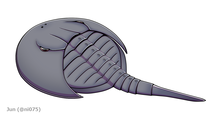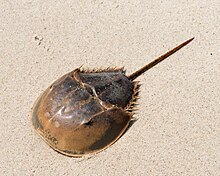Xiphosura
| Xiphosura | |
|---|---|

| |
| Restoration of Lunataspis, the oldest known xiphosuran | |

| |
| The extant Atlantic horseshoe crab (Limulus polyphemus) | |
| Scientific classification | |
| Domain: | Eukaryota |
| Kingdom: | Animalia |
| Phylum: | Arthropoda |
| Subphylum: | Chelicerata |
| Clade: | Prosomapoda |
| Order: | Xiphosura Latreille, 1802 |
| Groups | |
| |
Xiphosura (
The group has hardly changed in appearance in hundreds of millions of years; the modern horseshoe crabs look almost identical to prehistoric genera and are considered to be living fossils. The most notable difference between ancient and modern forms is that the abdominal segments in present species are fused into a single unit in adults.
Xiphosura were historically placed in the class Merostomata, although this term was intended to encompass also the
Description
Modern xiphosurans reach up to 60 cm (24 in) in adult length, but the Paleozoic species were often far smaller, some as small as 1 to 3 cm (0.39 to 1.18 in) long.
Their bodies are divided into an anterior
Xiphosurans have up to four eyes, located in the carapace. Two
The first four pairs of legs end in pincers, and have a series of spines, called the
The opisthosoma is divided into a forward mesosoma, with flattened appendages, and a metasoma at the rear, which has no appendages. In modern forms, the whole of the opisthosoma is fused into a single unsegmented structure.[14] The underside of the opisthosoma carries the genital openings and five pairs of flap-like gills.[10]
The opisthosoma terminates in a long caudal spine, commonly referred to as a telson (though this same term is also used for a different structure in crustaceans). The spine is highly mobile, and is used to push the animal upright if it is accidentally turned over.[10]
Internal anatomy
The mouth opens into a sclerotised
Xiphosurans have well-developed circulatory systems, with numerous
The excretory system consists of two pairs of coxal glands connected to a bladder that opens near the base of the last pair of walking legs. The brain is relatively large, and, as in many arthropods, surrounds the oesophagus. In both sexes, the single gonad lies next to the intestine and opens on the underside of the opisthosoma.[10]
Reproduction
Xiphosurans move to shallow water to mate. The male climbs onto the back of the female, gripping her with his first pair of walking legs. The female digs out a depression in the sand, and lays from 200 to 300 eggs, which the male covers with sperm. The pair then separates, and the female buries the eggs.[10]
The egg is about 2–3 mm (0.08–0.12 in) across. Inside the egg, the embryo goes through four molts before it hatches into a larva, often called a 'trilobite larva' due to its superficial resemblance to a trilobite. At this stage it has no telson yet, and the larva is lecithotrophic (non-feeding) and planktonic, subsisting on the maternal yolk before settling to the bottom to molt, after which the telson first appears.[15][16] Through a series of successive moults, the larva develops additional gills, increases the length of its caudal spine, and gradually assumes the adult form. Modern xiphosurans reach sexual maturity after about three years of growth.[10]
Evolutionary history
The oldest known stem-Xiphosuran,
Classification
Xiphosuran classification as of 2018[update]:[21][22]
Order Xiphosura Latreille, 1802
- †Maldybulakia Tesakov & Alekseev, 1998 (Devonian)
- †Willwerathia Størmer, 1969 (Devonian)
- †Kasibelinuridae Pickett, 1993 (Middle Devonian to Late Devonian)
- Suborder Xiphosurida
- †Infraorder Belinurina
- †Belinuridae Zittel & Eastman, 1913 (Middle Devonian to Upper Carboniferous)
- Infraorder Limulina
- †BellinuroopsisChernyshev, 1933 (Carboniferous)
- †Rolfeiidae Selden & Siveter, 1987 (Early Carboniferous to Early Permian)
- Superfamily †Paleolimuloidea Anderson & Selden, 1997
- †Paleolimulidae Raymond, 1944 (Carboniferous to Permian)
- Superfamily Limuloidea
- †ValloisellaRacheboeuf, 1992 (Carboniferous)
- †Austrolimulidae Riek, 1955 (Early Permian-Early Jurassic)
- LimulidaeZittel, 1885 (Carboniferous to recent)
- Limulinae Zittel, 1885 (Late Jurassic-Present)
- Tachypleinae Pocock, 1902 (Late Cretaceous-Recent)
- †
- †
- †Infraorder Belinurina
Taxa removed from Xiphosura
Two groups were originally included in the Xiphosura, but since have been assigned to separate classes:
- AglaspidaWalcott, 1911 (Cambrian to Ordovician)
- Chasmataspidida Caster & Brooks, 1956 (Lower Ordovician)
Cladogram
Cladogram after Lasmdell 2020.[1]
| Xiphosura |
| |||||||||||||||||||||||||||||||||||||||||||||||||||||||||||||||||||||||||||||||||||||||||||||||||||||||||||||||||||||||||||||||||||||||||||||||||||||||||||||||||||||||||||||||||||||||||||||||||||||||||
See also
- Synziphosurine
- List of xiphosurans
References
- ^ PMID 33335810.
- ^ "Xiphosuran". Oxford English Dictionary (Online ed.). Oxford University Press. (Subscription or participating institution membership required.)
- PMID 25405073.
- John Wiley & Sons. pp. 1–320.
- ISSN 0024-4082.
- PMID 30917194.
- PMID 31847768.
- PMID 35137183.
- ^ Botton, M.I. (1984) Diet and food preferences of the adult horseshoe crab Limulus polyphemus in Delaware Bay, New Jersey, USA, Marine Biology, 81, pp. 199-207
- ^ ISBN 978-0-03-056747-6.
- ^ Crystallographic Texture of the Arthropod Cuticle Using Synchrotron Wide Angle X-ray Diffraction
- ^ Exocuticular hyaline layer of sea scorpions and horseshoe crabs suggests cuticular fluorescence is plesiomorphic in chelicerates
- ^ R. C. Brusca & G. J. Brusca (2002). Invertebrates. Massachusetts: Sinauer Associates.
- S2CID 55271880.
- ^ Developmental ecology of the American horseshoe crab Limulus polyphemus
- ^ Metamorphosis of Limulus Polyphemus Trilobite Larvae: Role of Chemical and Structural Cues, Competency, and The Cost of Delayed Metamorphosis
- .
- ISSN 2296-6463.
- ^ Horseshoe crab genomes reveal the evolution of genes and microRNAs after three rounds of whole genome duplication
- ^ Chromosome-level assembly of the horseshoe crab genome provides insights into its genome evolution
- ^ Dunlop, J. A., Penney, D. & Jekel, D. 2018. A summary list of fossil spiders and their relatives. In World Spider Catalog. Natural History Museum Bern
- S2CID 85553811.
Further reading
- Jason A. Dunlop (1997). "Palaeozoic arachnids and their significance for arachnid phylogeny" (PDF). Proceedings of the 16th European Colloquium of Arachnology: 65–82. Archived from the original (PDF) on 2011-07-27. Retrieved 2011-03-27.
- J. A. Dunlop and P. A. Selden (1997). "The early history and phylogeny of the chelicerates" (PDF). In R. A. Fortey & R. H. Thomas (ed.). Arthropod Relationships. Systematics Association Special Volume Series 55. ]
- B. B. Rohdendorf (ed.) Fundamentals of Paleontology, vol. 9, Arthropoda-Tracheata and Chelicerata: 894 pp. [1991 English translation of Russian original, Smithsonian Institution Libraries and National Science Foundation].
- R. E. Snodgrass. 1952. A Textbook of Arthropod Anatomy. Hafner Publishing Company, New York.
External links
- Peripatus - an overview of arthropod relationships.
- Paleos - a site with a synoptic account of the Xiphosura, focused on fossils.
- Xiphosura - the article from the UCMP Web Taxa project.
- Xiphosura Educational Worksheet for Kids on EasyScienceforKids.
